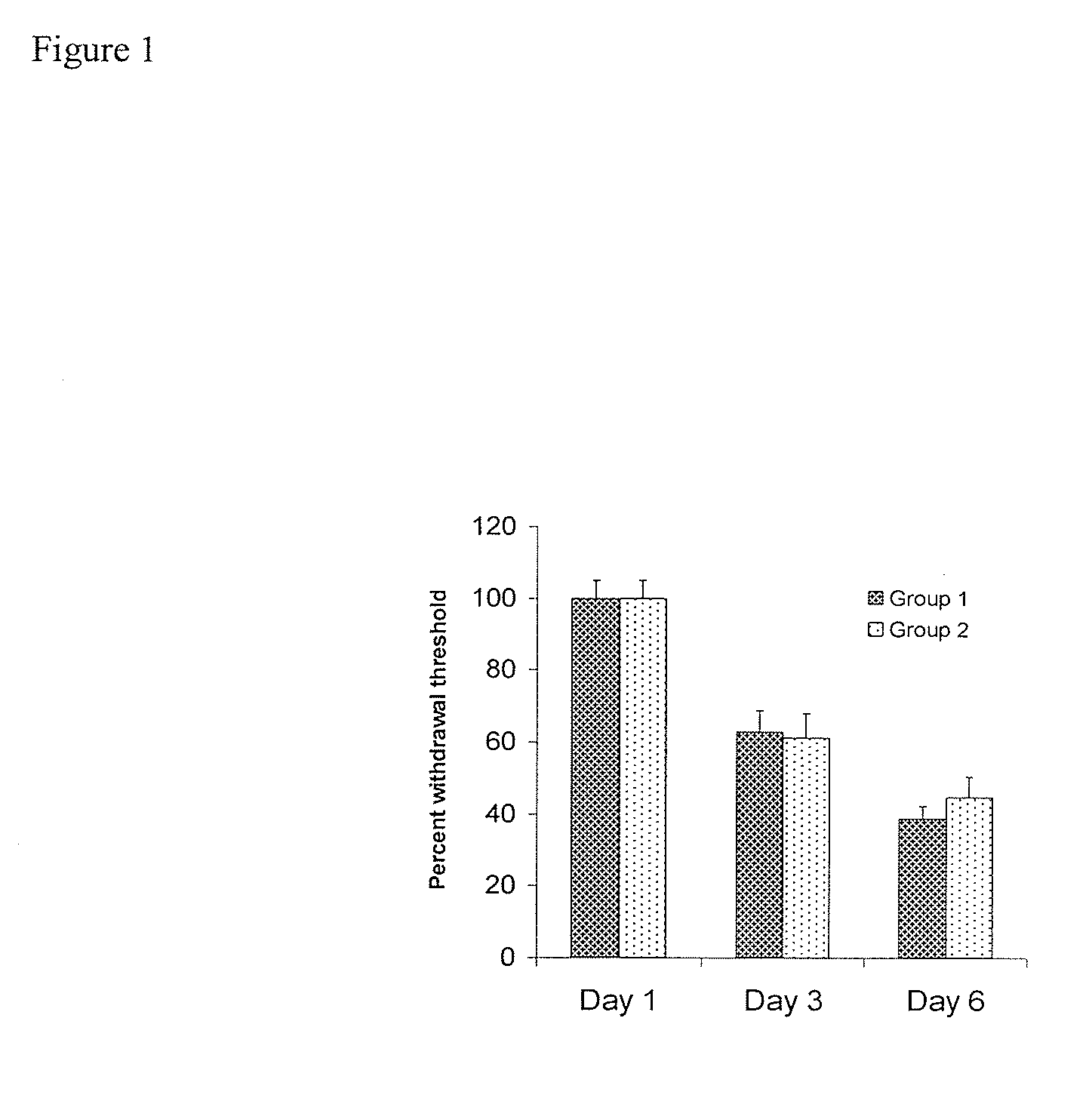Alleviating neuropathic pain with eets and seh inhibitors
- Summary
- Abstract
- Description
- Claims
- Application Information
AI Technical Summary
Benefits of technology
Problems solved by technology
Method used
Image
Examples
example 1
[0130]FIG. 1 shows that neuropathy was indeed induced, in the tested animals per group). When animals were treated with streptozocin, they showed a drastic reduction in their withdrawal latencies in a chronic manner (FIG. 1). This effect was very stable over the course of several months. Subsequent application of the sEHI AUDA reduced neuropathic pain in a dose and time dependant manner. This was evident in two independent pain tests. FIG. 2 shows the dose and time response relationship of AUDA and compound 1010 in neuropathic rats as determined using the von Frey test. Administration of AUDA at a moderate dose completely reversed the decrease in withdrawal threshold. The decrease in withdrawal threshold is an established and reliable indicator of analgesic activity. The activity of AUDA followed the plasma concentrations of the drug. AUDA lost its effect after four hours.
[0131]The results of the mechanical hyperalgesia test were in parallel to the observation with the mechanical al...
example 2
[0133]This Example sets forth the materials and methods used in the studies reported in Example 1.
[0134]Male Sprague-Dawley rats weighing 250-300 grains were used. Animals were individually housed at UC Davis Animal Resource Facility under standard conditions with free access to food and water, and maintained for at least 1 week before the experiments. Pain was quantified using three tests, the hind paw withdrawal latency test, the mechanical hyperalgesia test and the mechanical allodynia test. All the experiments were performed during the daytime.
[0135]Rats were first trained to the experimental chamber in two separate sessions. On the day of the induction of neuropathy, the animals' basal response to all three tests were measured and then streptozocin (50 mg / kg) was administered intravenously. Animals were then followed over time for the development of neuropathic pain. An inhibitor of sEH was administered subcutaneously one week after the onset of pain symptoms. A dose response s...
example 3
[0137]While monitoring epoxy / diol ratios of plasma fatty acids as a blood marker of efficacy, we surprisingly found an extensive reduction in pro-inflammatory fatty acid metabolites in severely inflamed mice treated with sEHI. These remarkable decreases particularly in PGE2 production compelled us to test if EETs and / or sEHI could reduce inflammatory pain. We found that both compounds alone and in combination were highly potent analgesic agents in rodents systemically or topically. AEPU, an early prototype sEH inhibitor, at 50 mg / kg, administered dermally, transiently increased the paw withdrawal latency of animals treated with intraplantar LPS in response to a mild heat stimulus. AEPU is metabolized rapidly but the temporal analgesic activity correlates with blood inhibitor levels. Another sEHI, TPAU, at 10 mg / kg showed a potency strikingly comparable to that of a moderate dose of morphine (1 mg / kg) but was clearly superior because of its better pharmacodynamics. TPAU treated anima...
PUM
| Property | Measurement | Unit |
|---|---|---|
| Time | aaaaa | aaaaa |
Abstract
Description
Claims
Application Information
 Login to View More
Login to View More - R&D
- Intellectual Property
- Life Sciences
- Materials
- Tech Scout
- Unparalleled Data Quality
- Higher Quality Content
- 60% Fewer Hallucinations
Browse by: Latest US Patents, China's latest patents, Technical Efficacy Thesaurus, Application Domain, Technology Topic, Popular Technical Reports.
© 2025 PatSnap. All rights reserved.Legal|Privacy policy|Modern Slavery Act Transparency Statement|Sitemap|About US| Contact US: help@patsnap.com



